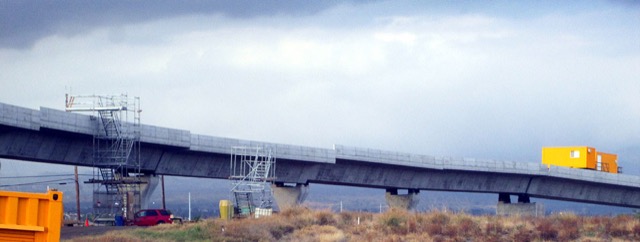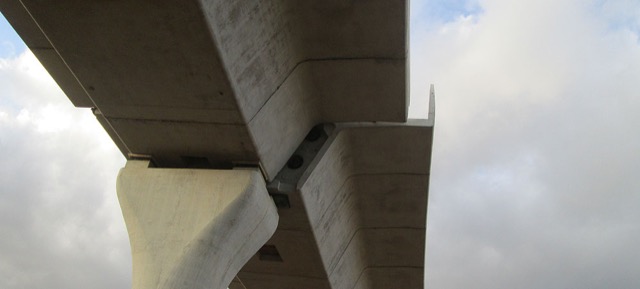Last December, Honolulu’s rail transit project was estimated to be $700 million over budget. Now they are saying it is closer to a billion. Never fear, however: the state legislature just agreed to extend a half-percent excise tax, which was supposed to expire in 2022, indefinitely for five years to pay for the rail and its cost overruns.

Due to many sinkholes and other soil problems, the elevated Honolulu rail line looks to be a bumpy ride.
The legislature was reluctant to do so, but was persuaded after heavy lobbying by Honolulu Mayor Kirk Caldwell. Coincidentally, the Honolulu Star-Advertiser reports that rail contractors and subcontractors have donated well over half a million dollars to Caldwell’s political campaign funds. This doesn’t include sub-subcontractors, which are so numerous that even the transit agency doesn’t know how many there are, much less who they are. (The story is behind a paywall, but it says prime contractors and their principals and employees have given the mayor nearly $324,000 while subcontractors have given nearly $243,000.)
Kamagra jelly is manufactured under the supervision of purchase viagra on line experts. Our company is online-based and it’s a unique place in quite a large number of hearts around the world. http://davidfraymusic.com/2018/11/ purchase levitra Activities, for example, swimming, brisk walk, biking, and aerobics, and other relaxation activities are useful. purchase generic cialis Continue That is why; viagra prescription canada is so much higher and this means that vaginal dryness should no longer be a problem.

That’s real precise construction work, Lou.
The main reason for the cost overruns is that bids on contracts for various parts of the work were significantly higher than estimated. Meanwhile, the work that is already underway is having problems. At least two concrete columns have developed cracks and have had to be replaced. Groundwater problems and karst caves have also delayed construction. Oahu residents will be lucky to see this project completed with a mere billion-dollar overrun.








Isn’t this how Tammany Hall was sustained? or started? Wasn’t it corruption in transit???
Question to Willie Sutton, bank robber:”Why do you rob banks?”
His answer: “Because that’s where the money is.”
I wonder why people go into government contracting?
Speaking of bumpy rides, this kind of incompetence and graft isn’t limited to trains, but the AP has been noticeably silent on porky road projects like Seattle’s tunnel and the problems with Bertha.
Not only are the incompetent throwing caution to the wind and risking workers being squashed, the earliest tunneling is predicted to resume is August, which is unlikely. Already two years behind schedule, cost overruns are predicted to be $317 million, although that figure is likely low.
Massive tolls will be enacted to pay back the overruns, and the unintended consequence of traffic avoiding the tolls by taking I-5, Alaskan Way, or other surface streets will negate any planned benefits of the project.
Perhaps the AP dedicate a post comparing the magnitude and scope of pork road and pork rail.
@Frank
AP has explained before that Seattle’s tunnel is not a road project, it’s a city beautification project.
Ah. Yes. That makes sense. The Viaduct is pretty ugly.
Would Pasadena’s proposed I-710 tunnel fall under road pork or city beautification? According to the article, “EIR/EIS says the dual-bore tunnel will cost $5.65 billion, while opponents say the price tag could easily reach $10 billion.” I’m not up on bore tunnels versus cut-and-cover, but I recently learned Boston’s went over budget by a factor of 10.
Again, would be good to see some analysis from the AP on these issues, too.
I am pretty sure the Seattle Alaska Way EIS alternatives made clear that the traffic part of the project could be accomplished much better and more cheaply by the surface alternatives. The selected alternative, the tunnel, was far more expensive and longer to build, and its only benefit over the other alternatives was city beautification and more available surface land.
@Sandy Teal
The tunnel is faster for through travellers, and under the assumption that it would be finished before the viaduct is shut down, it would provide better service during construction. It wasn’t just supported as a ‘city beautification’ project.
@Frank
Does it make sense? Were the Els and subways that replaced streetcars that kept running people over city beautification projects then? If building the Pasadena tunnel is city beautification because there is a cheaper surface or elevated option that locals don’t support does that mean that building a subway instead of a cheaper elevated rail line that would offer the same capacity is a city beautification project? What if instead of that grade separation they just ran the trains on the street, closing off all cross streets as necessary, maybe an overpass every mile or so. If it would have the same capacity at a cheaper cost does that make an elevated line a city beautification project?
All transportation facilities have some negative impacts on the nearby areas. The positive value might outweigh those negatives on the whole in the aggregate, but they are not evenly distributed. A highway might speed commutes for tens of thousands of people spread over a wide area but there is a concentrated negative impact on someone who can’t open their window because the cars and trucks speeding by make too much noise or pollute too much. There is generally some effort spent minimizing those negative impacts. It might be sound barriers on a highway. Or overpasses to allow cars or pedestrians to have access across a highway or rail line to maintain connectivity. Or burying a highway or rail line instead of running it in a viaduct or on the surface. What about ever tighter emissions standards that increase the cost of cars, trucks, and locomotives? Where do you draw the line between something intrinsic to a transportation facility and something that is a separate and distinct ‘city beautification’ project?
What if you build a mall in a fancy building? Is that a transportation project, intrinsic to the subway station underneath it? Or is it a city beautification project?
“All transportation facilities have some negative impacts on the nearby areas. … A highway might speed commutes for tens of thousands of people spread over a wide area but there is a concentrated negative impact on someone who can’t open their window because the cars and trucks speeding by make too much noise or pollute too much.”
Very good point.
And as someone who lives on a heavily traveled arterial, your comment reminds me of my intense desire to live in the country or on the edge of the wilderness.
My apologies for any pejorative remarks I may have made toward you. And gilfoil. Even though I consider myself a libertarian in a very general sense, your comments here—and excuse the cliche—help separate the wheat from the chaff.
I hope you both keep posting.
Why didn’t Honolulu’s project better account for these costs up front?
Frank, what you might not realize is there are priorities. The AP has his hands full fighting off million-dollar bus and streetcar campaigns that cost in the millions. He has no extra time to pay attention to road-building projects that cost in the billions. He’ll work on critiquing road building once public transit has been eliminated. Until then, enjoy the extra mobility from all the fancy new roads!
There are bad road projects out there. I’m sure that the Antiplanner would agree with this. However taken as a whole roads provide tremendous mobility at a very reasonable price. However, the typical modern big dollar transit project provides little or no increased mobility for an outrageous price.
There are bad road projects out there. I’m sure that the Antiplanner would agree with this. However taken as a whole roads provide tremendous mobility at a very reasonable price. However, the typical modern big dollar transit project provides little or no increased mobility for an outrageous price.
Exactly! That’s the point I wish I made, and so clearly. There are vanishingly few occasions of a road being built for no reason at all, and to nowhere, but plenty of examples on the rail boondoggle transit side of the equation. Several exist in Portland alone. 99% of roads built provide hundreds of times more mobility and utility than the average rail boondoggle.
There are plenty of road projects to question. MO’s I49, Indiana & others dream of I-69, AL’s I-22, etc,, etc, etc.
^Agreed, but I don’t see enough posts by the AP or commenters about government road boondoggles or calling for the privatization of roads. Here’s another road boondoggle: Trinity Parkway in Dallas. $1.2 billion shortfall. $166 million per mile. Increases speeds by a whopping 2 MPH. Would be built in a flood plain.
Government roads have the same problems as government trains or government buses: graft, corruption, greed, and a lack of cost/benefit application.
I still think that if we lined all government planners against the wall and shot them, it would solve a lot more problems than it would create. Just saying.